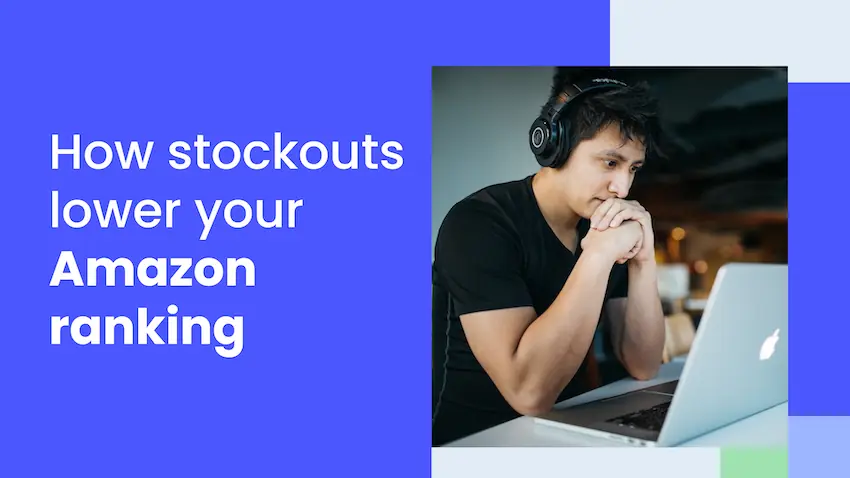Running an Amazon store is plenty of work on its own. You have to source products, manage customer service, returns and refunds and constantly stay on top of your store’s performance. But there is another major nuisance for eCommerce sellers: running out of stock. That is because Amazon is likely to lose out when you do. This article will explain why this happens, how Amazon responds, and what you can do to avoid such a situation.
Fund your inventory with 8fig!
Amazon ranks products that are out of stock lower
It might appear that in order to run a thriving Amazon store your main focus should be to make sure that your products are selling as fast as possible. A product running out of stock might feel like a point of pride, the sign of a successful eCommerce business. While that may be the case, it’s a double-edged sword. Seeing your products sell quickly is a good thing, of course, but the issues begin with a stockout. When this happens Amazon might respond by ranking your product lower on its listings.
In fact, Amazon even starts ranking products lower that aren’t sold out and are simply running low on inventory. The longer your stockout lasts, the more your keyword ranking will be affected. This might seem counterintuitive or unfair, but there is a reason behind it.
When someone browsing Amazon’s website wants to buy a product that is out of stock, one of four things can happen: 1) they buy from a competitor on Amazon, 2) they buy from a different online store like Walmart, 3) they delay buying the product or 4) they don’t buy it to begin with. And in the rare worst-case scenario for Amazon, a customer might decide not to buy your product, as well as the rest of the items in their shopping cart.
Apart from the first outcome, all of these options aren’t in Amazon’s interest. In order to prevent such a scenario, it has one effective option: to lower your product’s ranking. By making sure that fewer potential customers see it, Amazon reduces the chance that a purchase won’t happen on its website. If you experience frequent stockouts there is a high chance that your keyword ranking will suffer noticeably.
What does this mean for you? Your store will reach a smaller audience and therefore sell less, even when your inventory is full again. It will take time and a good sales performance to earn your hard-earned previous ranking back. Additionally, no new sales mean no recent product reviews, which have a strong impact on a customer’s decision to buy or not.
We all know that reviews are decisive in getting people to go through with their purchase, but making sure that new ones are always flowing in is also important. This is because, to someone browsing Amazon, knowing that others are still buying the product and happy with it indicates that the quality hasn’t dropped and suggests it is still able to compete with the latest alternatives.
Potential buyers might also feel a certain amount of disappointment if they find that a heavily promoted item is no longer available for purchase, which can harm your store’s reputation. Competitors will likely vacuum up all those unsatisfied potential customers, meaning they also get a rankings advantage over you. Depending on how long it takes for you to restock and resume sales, these factors can put a major dent in your profit margins.
Amazon stockouts lead to outcomes like:
- Customers purchase from competitors instead
- They buy from a different website
- Customers delay their purchase
- They decide not to buy anything
*Except for option 1, all of these outcomes go against Amazon’s interest.
How to avoid harming your Amazon ranking
We’ll ask a few quick questions to better understand your specific business needs. Then, we’ll build a funding plan tailored to your expenses.
Subscribe to the eCommerce newsletter for
top industry insights
Cease advertising
The obvious solution not to harm your Amazon ranking like this is not to run out of stock. However, you have several other options even though it might seem like you’re powerless while you’re watching your inventory trickle away. One of the best things to do once you see that a product might be selling out before your next batch comes in is to stop any advertising and PPC campaigns you might be running. Halt any marketing, ads and discounts that were in place beforehand. Doing so will likely slow the stream of purchases and buy you more time.
This step has the additional benefit of showing you how effective your advertising campaigns actually are, and how much natural traffic your products attract. Once your inventory is full again you can recommence your marketing operations.
Raise prices (slowly)
If you notice that your sales are still not falling in a meaningful way after ending your advertising campaigns, you can try raising your prices. This can reduce demand just enough until you are able to restock, while also increasing your profit margins. But be careful, raising your price too much might halt positive sales momentum, which would also be counterproductive. It also risks potential customers buying from your competitors instead, which should be avoided whenever possible.
The best approach is to raise prices a little at first, and wait before doing so again. This will give you the time to understand whether the demand for your product is strong enough to overcome a price increase. Warning: increasing your price too much and leaving this raise in place for too long can negatively affect your Amazon ranking more than simply running out of stock would.
Ensure that a new shipment is always inbound
The most straightforward way to prevent an Amazon stockout is to ensure that you have regular shipments of inventory coming in at all times. Of course, this is easier said than done but there are several good strategies available here. One solution is to order smaller batches of products, but have them shipped more frequently. This will allow you to quickly adapt to market trends and increase or decrease order sizes accordingly.
Alternatively, you might find that you can negotiate a better rate with your supplier if you order larger shipments less frequently. This might help you cut some costs although it does mean you’ll be more exposed if you still end up running low on stock. In general, you want to keep a close eye on your inventory and track and manage it as well as possible to avoid any surprises.
Communicate with your suppliers
Having clear and open communication with your supplier is almost always a good thing. If you want to gain a better understanding of the inner workings of your supply chain, you should talk to them. Ask about the supplier’s lead times or the amount of time it takes them to have a batch ready for shipping after you send in your order. This will help you understand how far in advance you should be finishing up your orders.
Additionally, you should find out about their monthly guaranteed production. Knowing this will help you understand if you need to find a backup supplier if you start to notice a large increase in orders. After talking to your supplier you should try to calculate the reorder point, which is when your stock hits a level where the next inventory order should go through.
To ace this process, it is important to have a good understanding of your supplier’s procedures, and factor in delays due to production setbacks or late shipments. You might also want to consider holding backup stock in a local warehouse for moments like these.
Might also interest you:
Improve your logistics
If you find that your store often faces stockouts, you should take a close look at your supply chain. Perhaps there are inefficiencies causing this that you oversaw in the past. Even well-run stores usually have some wrinkles that can be ironed out. The first step should be to take a look at the shipments your supplier sends. Are they prone to delays? Do they take noticeably longer than those of competitors? Is their packaging adequate or does it result in breakage and loss of inventory?
Inform yourself about the options available. Perhaps another supplier can get you the same quality product in less time and more reliably. They might offer improved tracking services so you can consistently stay aware of your latest shipment’s location. If running out of stock is a regular possibility for your Amazon store, you need to make sure your shipments are coming in as efficiently as possible, that means finding the best-possible shipping partner.
Analyze the market
It is always a good idea to take a close look at market trends surrounding your products. We all know that Amazon sales can be highly unpredictable; during some months your products are selling like hotcakes while their popularity wanes during others. If you are selling, for example, sports clothing for kids, you should keep a close eye on the beginning of the school year, when purchases are very likely to inflate dramatically.
This means you need to prepare by ordering a larger shipment than usual. High-volume periods like these can mean immense growth for your Amazon store. Running out of stock at this time can mean losing huge sums in potential income.
Properly understanding Amazon’s data can be priceless. Knowing the latest trends in Amazon keyword searches can help you predict if you need to stock up or slow down inventory orders. A service like JungleScout provides you with search data, as well as reports on how many competitors are also selling your products. This can make predicting sales numbers much more intuitive. Learning how to recognize market trends can be a huge advantage to avoid stockouts on your Amazon storefront.
Perhaps you are using technology that isn’t ideal for optimizing your performance, and if so, it might just be better to let the experts take over. There is a whole ecosystem of services to help online sellers run their businesses. A company like Zee can help you streamline your supply chain and respond quickly to a shipment being held up for any reason. Instead of dealing with headaches like tax forms, import law compliance, or freight insurance, let their team handle it.
They are also able to help you determine the best suppliers through research and vetting. That can mean more reliable shipping as well as better prices and conditions. If dealing with suppliers and their shipments isn’t your forte, it might be worth partnering with a company that oversees these matters for you.
Inject growth capital into your business
If your cash flow is tight and you rely on sales from past batches before ordering new shipments, you should look into a financing plan that allows you to keep inventory full, sales high and your business growing.
One of eCommerce sellers’ biggest issues is running out of funding right as their business is taking off. Growth capital solutions let you invest in the products that are selling in high amounts to maximize your profits and boost growth. Using this investment to order larger or more frequent shipments is a great way to ensure that you don’t run out of stock. This also means that your Amazon ranking won’t face any hindrances and can go from growth to growth, as you boost your store’s brand and keep standing out from the competition.
Popular content
View articles
8fig offers one of the best funding options for eCommerce sellers. You provide details about your product and sales goals and receive funding to make this aspiration a reality. Stressing about available capital won’t be an issue anymore because 8fig’s funding is designed to optimize your cash flow. Instead of one lump-sum, you get continuous injections when your supply chain needs it most. In addition, your remittance schedule is completely flexible.
8fig knows that eCommerce supply chains are prone to disruptions and delays, so if something comes up you can quickly and easily adjust your funding plan and remittance schedule to match your projected sales. This means you can focus on selling your products and growing your store.
An additional benefit of going with 8fig is that it offers free software for overseeing and planning your supply chain. It integrates with your Amazon store and helps you measure the health and performance of your business. This makes it much easier to tailor how much inventory your next shipment should include with your expected sales in mind. Sign up today and take your business to the next level.
Have article ideas, requests, or collaboration proposals? Reach out to us at editor@8fig.co – we’d love to hear from you.



